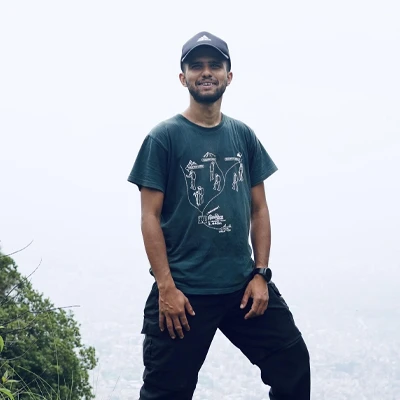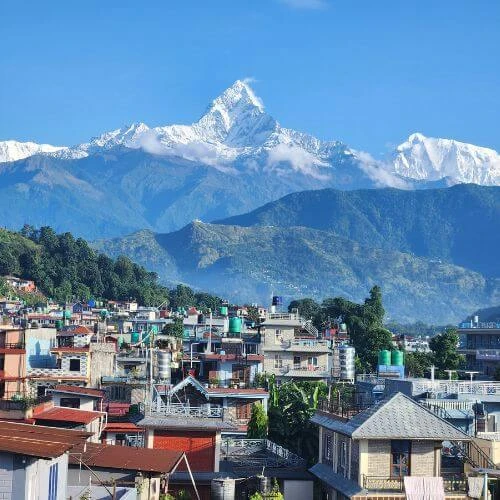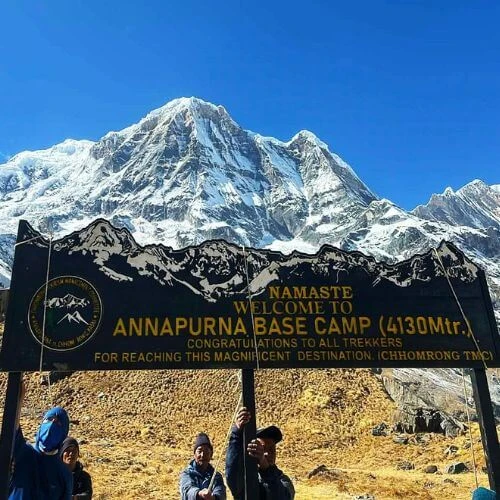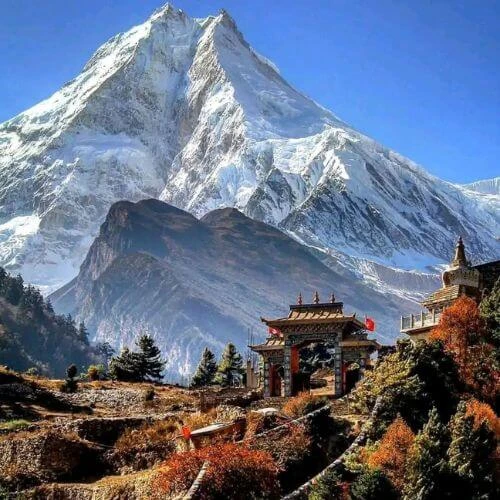UNESCO World Heritage Sites of Nepal
Swyambhunath (The Famous Monkey Temple)
The esteemed Buddhist site, Swyambhunath, boasts a prominent whitewashed stupa and holds a significant place of worship in Nepal. Situated 3 km west of Kathmandu, the name Swyambhu translates to "self-existent one." According to ancient legend, Swyambhunath was once an island thousands of years ago. In 460, King Manadeva contributed to the construction of the stupa, and in the 17th century, King Pratap Malla not only improved the architecture but also added a staircase leading to the holy site. Swyambhunath acquired UNESCO World Heritage Site status in 1979, providing a breathtaking view of the entire Kathmandu Valley.
Swyambhunath Now: Currently, the stupa is a solid hemisphere constructed from clay and bricks. It upholds a tall conical spire crowned with a copper pinnacle, featuring Lord Buddha's eyes decorated on all four sides of the spire base.
Major monuments to explore in Swyambhunath
- Western Stupa: The west from the main stupa, you will reach a smaller stupa near the tourist parking. Just back is a gompa surrounded by rest houses for pilgrims and a vital shrine to Saraswati, the divinity of knowledge and learning.
- The Great Dorje (Thunderbolt): At the top of the eastern staircase, a significant brass-plate thunderbolt, a fundamental symbol in Tibetan Buddhism, commands attention. In traditions, the Dorje represents male power, with female power symbolized by a ceremonial bell. Referred to as a "Vajra" in Sanskrit, this thunderbolt serves as a Tantric symbol of enlightenment's influence. It not only eradicates ignorance but stands indestructible in its own right
Other monuments to see in this area include
Shantipur (the place of peace)
Agnipur (marked by 2 small lions in front of it)
Nagpur (small tank with a snake “idol” at the bottom of it)
The Harati Temple (dedicated to Harati, the goddess of all children)
Dipankar Buddha Statue (built by single peace stone in the 7th century)
Buddha Amideva Park
Entry Fee
How to get to the Monkey Temple?
Swyambhunath is easily accessible by taxi, and if you're in Thamel, a quick 35-minute walk will bring you to the stupa. Alternatively, a public bus from Sorahkhutte can take you to the bottom of the hill where the stupa is situated. From there, a 15-20 minute hike awaits, offering a delightful experience with encounters with playful monkeys along the way.
Pashupatinath Temple
For Hindu adherents, Pashupatinath is a holy shrine and is one of the most aged Hindu temples dedicated to Lord Shiva. Pashupati means "Lord of all animals". Built in the 1st century and afterward renovated by the Malla Kings, the area itself is said to have existed from the beginning of the millennium when a "Shiva Lingam" was uncovered here. This remarkable temple stretches on both sides of the Bagmati River which is considered sacred by Hindus and was enlisted as a World Heritage Site in 1979 AD.

The primary pagoda-style temple has a roof adorned with gold, silver-covered sides on all four facets, and exquisite wood carvings. Hindus conduct cremations on elevated platforms by the river. Access to the main temple gates is restricted to Hindus only. Inside the inner shrine, a Shiva Lingam is present, while outside, the statue of Nandi, the bull and the divine vehicle of Shiva, is positioned.
Visit this highly urged religious hub for a blend of religious, spiritual, and cultural experiences. Located 3 km northeast of Kathmandu on the banks of the Bagmati River, the temple site also includes Jaya Bageshori, Devpatan, Gaushala, and Gaurighat. There are around 490 temples, 15 shrines of Lord Shiva, and 12 Jyotirlinga to explore.
Cremation in Pashupatinath

Cremation is the procedure of reducing a dead body to small fragments resembling ash by exposing it to flames and extreme heat, followed by the pulverization of bone fragments. The practice of cremation at Pashupatinath in Nepal has ancient roots, with the belief that a Hindu cremated here will be reincarnated as a human in the next life.
Birupakshya
Also recognized as Kirateswar Mahadev, Birupakshya is the revered deity of the Kirat community. Positioned along the Bagmati River's edge, the statue holds a belief that the world would face devastation if it were to arise in its entirety.
Major monuments to see in this area
Entrance Fees
How to reach Pashupatinath Temple?
Situated close to Tribhuvan International Airport, Pashupatinath Temple is easily accessible via various local buses departing from the central city. For a direct visit, consider taking a taxi directly from your current location to reach the temple.
Bouddhanath
This remarkable site stands as the epitome of Tibetan Buddhism, situated 8 km east of Kathmandu. Completed by Licchavis King Man Dev in the 5th century AD, this site earned a spot on UNESCO's World Heritage List in 1979 and remains one of Kathmandu's most visited tourist destinations. The stupa is among the world's largest dome-shaped stupas, adorned with 108 small images of the Dhyani Buddha Amitabh and a rotation of prayer wheels at its base. Following the Chinese invasion in 1959, a group of Tibetans sought refuge at this renowned Buddhist Chaitya, infusing the stupa with revived energy. As you walk around the base, the ambient sounds include the resonant chants of monks and the mild creaking of prayer wheels.

Resembling a giant Mandala representing the Buddhist Cosmos, the Boudhanath Stupa is intricately linked with the Bodhisattva (Padmapani) in addition to the Five Dhyani Buddhas. Around the base, you'll find sculptures portraying the Bodhisattva in 108 forms. The stupa's base consists of three progressively decreasing platforms, symbolizing the body, mind, and speech. Every segment within the main stupa holds an influential meaning, contributing to the rich symbolism manifested in this sacred structure.
Entrance Fee
How to reach Bouddhanath?
Arrange for a taxi to pick you up at your present location, or go for public transportation available from Ratna Park, Sundhara, and Gongabu. Buses departing from these stops for Boudhanath Stupa operate at regular intervals, providing a convenient and routine service that will take you directly to the stupa's gate.
Changunarayan
Situated on a hilltop known as Changu or Dolagiri, the historic Hindu temple of Changunarayan reverences Lord Vishnu. As one of Nepal's oldest temples and an ancient archaeological place, the Chanunarayan Temple dates back to the control of Haridatta Burma in 323 BC. Situated 15 km from Kathmandu city, this iconic temple stands as a milestone in Nepali temple architecture, showcasing detailed embossed works that mark it as a significant landmark.

Sculptures and artworks representing Lord Vishnu surround the temple, with the props supporting the roof intricately carved with the ten incarnations of Lord Vishnu and various other idols. At the primary western entrance gate, a stone pillar proudly depicts the Sankha, Chakra, Kamal, and Khadga at its top. This pillar bears a Sanskrit notation, recognized as Nepal's oldest inscription, and was erected by King Manadeva in 464 AD, marking the Eastern gate entrance.
Major monuments to see in this area
- Chinnamasta: Temple devoted to Chinnamasta Devi, who beheaded herself, and offered her blood to feed the hungry Dakini and Varnini.
- Garuda: Flying vehicle of Lord Vishnu which has got a mortal face and is devotee of Vishnu.
- Historical Pillar: The inscription is considered to be the oldest inscription of Nepal and the stone inscription pillar was put together by Lichhavi King Manadeva in 464 AD.
- Bishworup: The 7th-century stone sculpture beautifully inscribed that depicts the scene from the Bhagwat Gita, in which Lord Krishna displays his universal form to his devotee Arjun.
- Narasimha: A 7th-century sculpture of Narasimha, an incarnation of Lord Vishnu.
- Garuda Narayan: 7th-century stone sculpture of Vishnu riding on Garuda. This sculpture has been printed in the 10 rupee paper note of Nepal.
- Vishnu Bikrant: 7th-century statue of Trivikram Vishnu that shows the scene of popular Hindu myth of Lord Vishnu and his beloved Bali Raja.
Entrance Fees
How to get to Changunarayan Temple?
Changu Narayan does not have direct bus services from Kathmandu, but you have alternatives. You can take a public bus to Changu Narayan from Bhaktapur, and to get to Bhaktapur, you can hire a taxi or use public buses leaving Old Bus Park or Ratna Park. Changu Narayan is a famous destination for day hikes from Bhaktapur, offering an opportunity to hike to the temple. For a faster and more suitable alternative, consider taking a taxi directly from your current location.
Lumbini
Lumbini, the motherland of Lord Buddha was enlisted as a UNESCO World Heritage Site in 1997 AD. Lumbini lies in the southern Terai flats of Nepal and is about 300 km southwest of Kathmandu. This is one of the holy pilgrimage sites for Buddhists. The Indian majesty Ashoka visited Lumbini in 249 BC, leaving behind an inscribed sandstone pillar to celebrate the occasion. After being misplaced for centuries, Ashoka's pillar was rediscovered by the governor of Palpa, in 1896.

The UNDP allotted almost one million dollars to fund the design of a Master Plan aimed at developing Lumbini. This thorough plan incorporates various archaeological and engineering studies. Within the blueprint for Lumbini Garden's development, three major components stand out: The Sacred Garden, The Monastic Zone, and the New Lumbini Village. The layout is structured in a north-south orientation, with Lumbini Village and the Monastic Zone positioned to the north. The central focus of the design rests on the Sacred Garden, situated to the south.
Major Monuments to explore in this area
- Ashoka Pillar: After being lost for ages, Asoka's pillar was rediscovered by the governor of Palpa, Khadga Shumsher Rana, in 1896. The 6m-high pink sandstone pillar has now been returned to its original spot in front of the Maya Devi Temple.
- World Peace Pagoda: Japanese Buddhists built the striking white World Peace Pagoda outside the main compound. The gleaming golden statue within portrays the Buddha in the posture he took at the time of his birth.
- Maya Devi Temple: At the spiritual spirit of Lumbini lies the Maya Devi Temple, marking the exact location where Queen Maya Devi delivered Siddhartha Gautam around 623 BC. To enter, purchase your ticket 50 meters north of the Sacred Garden gate and kindly remove your shoes upon access. A key pilgrimage site, the focal point is a sandstone carving depicting the Buddha's birth, reportedly left by the Malla King, Ripu Malla, in the 14th century when Maya Devi was regarded as an incarnation of the Hindu mother goddess. Beside the temple, the sacred pond is believed to be where Maya Devi bathed before giving birth to the Buddha.
- The Peace Flame: Situated at the canal's southern end, the Eternal Peace Flame came into existence in 1986 AD as a tribute to the International Year of Peace. It serves as a symbol of the constant endeavor to foster peace and harmony worldwide.
Entrance Fee
How to reach Lumbini?
Reaching Lumbini presents two options: an overland travel or a flight. The highway route takes roughly 8-9 hours from Kathmandu, with options of tourist buses or private vehicles for hire. Alternatively, a flight to Bhairahawa Airport takes around 35 minutes, followed by a 30-minute drive to reach Lumbini.
Sagarmatha National Park
Established as the first UNESCO Natural World Heritage Site of Nepal in 1979, this Himalayan park is none other than Sagarmatha National Park. Nestled at the foothills of the Himalayas, it spans an extended area of 1,148 sq. km. Famous for its pristine mountains, glaciers, and panoramic valleys inhabited by Sherpas, the park is a unique heaven. Boasting an exceptional diversity of birdlife, plant species, and exotic animals, Sagarmatha National Park is adorned with blue pine, birch, rhododendrons, and more, enhancing its natural sensation. Home to some of the world's highest peaks, including the globally acclaimed Mount Everest, it serves as a storage of rare Himalayan herbs, wildlife, and blossoms.
- Activities: exploring Sherpa culture, trekking, mountaineering, peak climbing
- Access: flight to Lukla which is 40 minutes by air from Kathmandu or take a bus to Jiri, and trek onward.
- Park Headquarter: Namche Bazaar
- Accommodation: Tea houses, resorts, lodges, camping.

Entrance Fee
For foreign nationals: NPR 3,000
For SAARC national: NPR 1,500
For Nepalese citizens: NPR 100
Chitwan National Park
Formerly named the Royal Chitwan National Park, Chitwan National Park earned the distinction of Nepal's first national park in 1973. Recognized as a World Heritage site in 1984 AD, this broad national park covers 932 sq. km. in the inner Terai belt of Chitwan. Holding a pristine natural environment, it showcases a diverse and rare ecosystem. The park offers an enriching wilderness safari, allowing visitors to canoe through its rivers, encounter crocodiles, and embark on exhilarating adventures. Home to diverse wildlife species, including the prominent Asian one-horned rhino and the Royal Bengal Tiger, the park provides a unique opportunity to observe these creatures in their natural habitat. Staying in one of the park's lodgings, you'll be guided on a cultural tour, gaining insights into the local lifestyle, including the highly appealing Tharu culture.

Entrance Fee
For Foreign nationals: NPR 1,500 per person per day
For SAARC nationals: NPR 750 per person per day
For Nepalese citizens: NPR 100 per day per entry
Explore our Nepal Short Tours, Chitwan Jungle Safari package to explore Chitwan National Park an UNESCO World Heritage Site of Nepal.
Access: The park's main office at Kasara is easily accessible, only a 21-km drive from Bharatpur, which is a quick 20-minute flight or a 147 km journey by road from Kathmandu.
Kathmandu Durbar Square
Until 1896, the entire Durbar Square included Nepal's Royal Palace. The term "Durbar" derives from the ancient Persian name, signifying "palace," a terminology dating back to the Mughal rule in parts of India. In that era, Kathmandu served as a key trading route. Today, we can immerse ourselves in history by strolling through this lively square and gaining insights into its rich past.

Hanuman Dhoka, once the Royal Palace of the Malla Kings and afterward inherited by the Shah dynasty, continues to serve as a venue for various practices and ceremonies. Within the palace, museums let you explore the culture, religion, traditions, customs, and history associated with the Royal Palaces. Emerging from its historical leftovers, the restored Durbar Square gained worldwide acclaim in 1979 upon receiving the prestigious designation as a UNESCO World Heritage Site.
This site holds structures, temples, statues, and artifacts dating back to the Malla and Shah dynasty eras. The Durbar Square once enclosed courtyards and temples, many of which were destroyed by the mega earthquake in 2015, leaving only a handful of courtyards undamaged. The surviving intricate wood and stone carvings, grand temples, and lively ambiance mirror the essence of Kathmandu itself. Quick restoration efforts, extending beyond Kathmandu to other areas affected by the earthquake, underscore the nation's determination and solidity. Today, as visitors wander through Kathmandu Durbar Square, the narrative of recovery is noticeable.
Top Sights to Explore in Kathmandu Durbar Square
House of Kumari (Kumari Ghar)
Within the Kathmandu Valley, there are three Kumaris, young girls carefully selected through a strict screening process for representing the goddess Taleju. The Royal Kumari lives in Kathmandu Durbar Square, distanced from her family and cared for by dedicated attendants. Her tenure as Kumari concludes upon experiencing her first menstruation. She only ventures outside during official functions, and her feet are never allowed to touch the ground. If lucky, one might glimpse her through the central window, both from outside and within the courtyard.
Gaddi Baithak
The final part of this square constitutes a significant portion of the old Royal Palace. The term "gaddi" translates to "throne," and "baithak" signifies a "meeting room." The European influence is apparent, evident in its robust white columns. Constructed in 1908 during the Rana regime, characterized by a significant British presence, this edifice served as a reception lobby for foreign dignitaries. Unfortunately, the southern side of Gaddi Baithak fell victim to the 2015 earthquake. In 2018, the building underwent repairs, incorporating some minor decorative changes.
Kasthamandap
Kathmandu derives its name from an ancient structure sadly demolished in the 2015 earthquake. Although its historical roots are uncertain, local tradition claims that the three-roofed building, constructed around the 12th century from a single Sal tree, has foundations dating back to the 7th century based on recent research. The structure was completely razed in the 2015 earthquake but has since been reconstructed in a new form, appearing rejuvenated. Notably, Kasthamandap was never consecrated as a temple originally, it served as a rest-house. It was later converted into a shrine for Gorakhnath in 1379.
Taleju Temple
Constructed in 1564 atop the site of another temple, the Taleju Temple holds importance as the goddess of both the Malla Kings and later the Shah Kings in the Kathmandu Valley. On clear days, its glorious presence can be observed all the way from Bhaktapur. The temple advanced to such heights, and stands on 12 plinths, with the 8th plinth constructing a protective wall around it. In front of this wall, 12 smaller temples are positioned, while another set of 4 similar temples stands on the opposite side. Unfortunately, access to the temple is restricted, and the closest one can get is by entering through the old Royal Palace, just a few minutes away.
Other must-see attractions include:
Entree Fee
For SAARC national: NPR 150
For foreign nationals: NPR 1,000 - get a visitor’s pass for free if you plan to visit more than once. \
Access to Kathmandu Durbar Square
Reaching Kathmandu Durbar Square offers several routes, with the most suitable starting point being Thamel. Embark on your journey from Thamel, proceeding along a route leading to Chetrapati and onward to Ason. The streets of Ason are bustling and lively. Navigate towards Indra Chowk and continue towards Bishal Bazaar or go for the narrow Makhan road. A brief stroll, approximately a minute, brings you to Kathmandu Durbar Square. If you find yourself alone, feel free to seek directions from the locals. Alternatively, for a more comfortable option, you can take a taxi from your hotel.
Bhaktapur Durbar Square
Located in the eastern territory of the Kathmandu Valley, Bhaktapur, often referred to as the "City of Devotees," is also known as Khwopa or Bhadgaon. Renowned as the fortress of ancient Nepali culture and compelling artistry, this picturesque destination earned a spot on the UNESCO Heritage List in 1979. Each historical monument reflects the medieval culture, religion, and customs of Nepal. Bhaktapur Durbar Square's key attractions span from west to east. Upon arrival, the first point of order is the ticket counter. A white archway that once stood to the right was unfortunately destroyed in the 2015 earthquake and now serves as the location where visitors are required to present their tickets. Bhaktapur is largely inhabited by the Newari population, making it the sole place in Nepal that has retained its authenticity, untouched by Western culture. In addition to ancient temples and statues, the area boasts top-notch restaurants and hotels, catering to the diverse needs and preferences of tourists.

Top Sights to Explore in Kathmandu Durbar Square
Entrance Fee
Access to Bhaktapur Durbar Square
Embarking from Thamel to Bhaktapur is easily accessible by taxi, with the drive spanning approximately 45 minutes. Alternatively, local bus services offer a feasible option. To catch a local bus, make your way to Naya Bus Park or Ratna Park, where buses to Bhaktapur depart every ten or fifteen minutes. Upon arrival in Bhaktapur, a brief walk of about 10-15 minutes will lead you to the Durbar Square.
Patan Durbar Square
Referred to as Lalitpur in Sanskrit, Patan is situated on the opposite side of the Bagmati River from Kathmandu. The existence of Ashokan stupas in and around Patan City suggests a visit by the Indian Emperor Ashoka in the third century. Multiple signs align with the general belief that King Yalambar of the Kirats established the city in the second century. The original inhabitants, subsequently known as the Newars, bestowed the name "Yala" upon Patan, a name that has lasted over time. Until the late 18th century, Patan functioned as an independent state just like Kathmandu and Bhaktapur. However, with the unification of Nepal under King Prithvi Narayan Shah, who designated Kathmandu as the capital, Patan's status changed.

In 1979, UNESCO designated Patan Durbar Square as a World Heritage Site. The period from the 14th to the 18th century witnessed a wave in temple constructions within the square, a sensation attributed to the Malla era. Serving as an expansive museum, it showcases the pinnacle of Newari craftsmanship. Within this ancient royal courtyard, Hindu and Buddhist monuments are incorporated, each holding historical significance. Patan is essentially divided into four regions: South Patan, Patan Durbar Square, North Patan, and West Patan.
Patan Museum
Upon re-entering Mul Chowk with your museum ticket, you have the opportunity to ascend the stairs leading to the newly refurbished museum. Notably, the museum's architectural galleries stand out, offering intricate descriptions of the construction techniques employed in various temples across Patan. Within, you'll encounter impressive bronze castings, skillful stonework, and a collection of artifacts hailing from the prime era of Patan.
Top Sights to Explore in Patan Durbar Square
Mul Chowk
Sundari Chowk
Bhandarkhal Tank
Krishna Mandir Temple
The Golden Temple
Manga Hiti
Kumbeshwar Temple
Entrance Fee
Access to Patan Durbar Square
For a better convenience, a taxi ride from Thamel to Patan Durbar Square is a suitable choice. The taxi will conveniently drop you at the Durbar Square entrance, requiring approximately 20 minutes if traffic is light. Alternatively, public transportation options are accessible, including tuk-tuks or public buses departing from Ratna Park or Sundhara vehicle station.
At the end
Explore these 10 UNESCO World Heritage Sites in Nepal, a must-visit in your lifetime. Contact us for tailored heritage walks and day tours, available at your convenience – our dedicated service is always at your disposal. We trust you found this informative blog enjoyable.
What is Swayambhunath famous for?
Swayambhunath, also known as the Monkey Temple, is renowned for being an ancient stupa situated atop a hill west of Kathmandu Valley in Nepal. This UNESCO World Heritage Site is famous for its striking architecture, featuring a whitewashed dome with a gilded spire and a pair of large Buddha eyes on each side. The eyes, known as the "Eyes of Buddha," are symbolic of knowledge and compassion.
What is the Significance of Lumbini as UNESCO World Heritage Site?
The UNESCO title acknowledges Lumbini's outstanding universal value, both culturally and historically. The site surrounds the Maya Devi Temple, which marks the exact spot where Queen Maya Devi is believed to have given birth to Siddhartha Gautama in approximately 623 BC. The Ashoka Pillar, erected by the Indian Emperor Ashoka in the 3rd century BC, additionally adds to the historical significance of Lumbini.
How many UNESCO world heritage sites are there in Nepal?
Nepal has a total of 10 UNESCO World Heritage Sites. These sites are well known for their cultural, natural, and historical value, contributing to the enormous heritage and diversity of Nepal.














